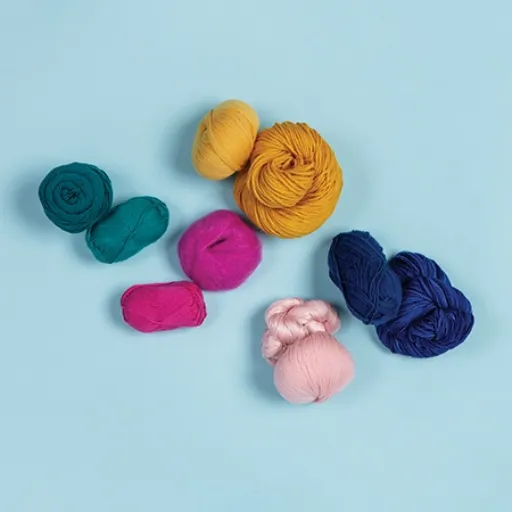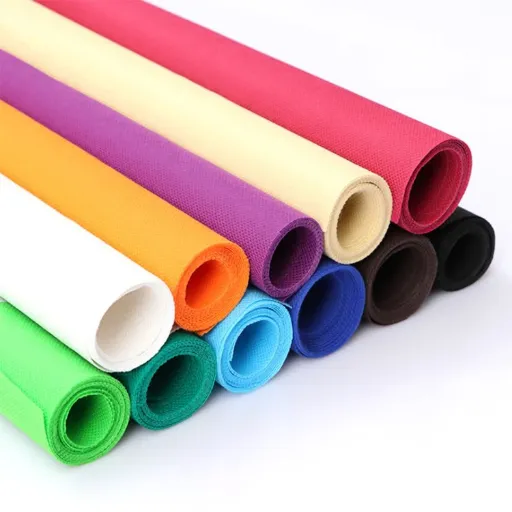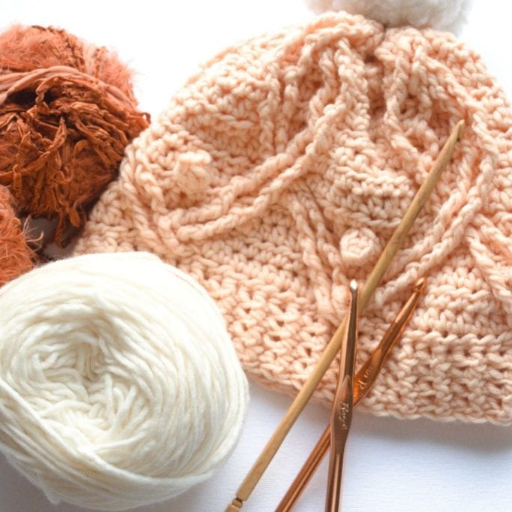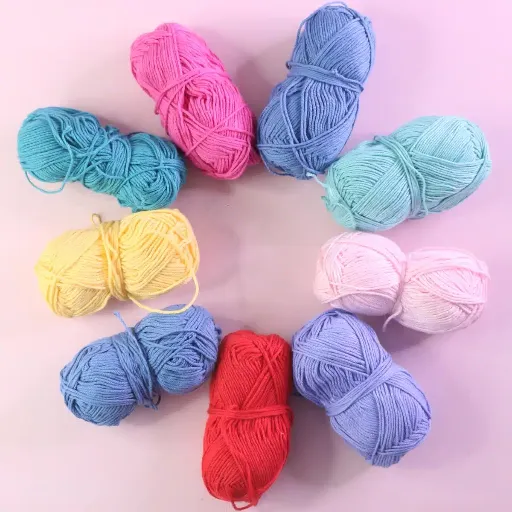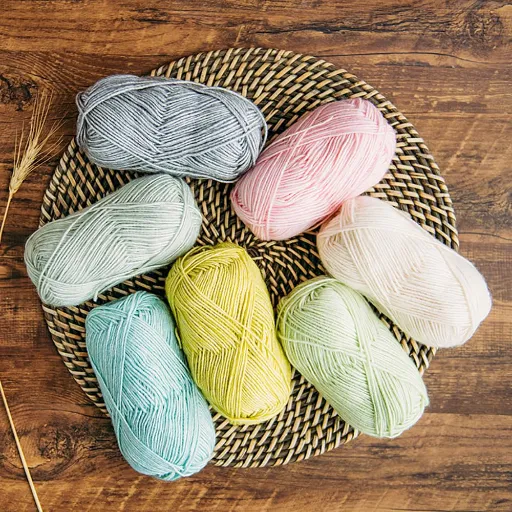Acrylic yarn is one of the most affordable, durable, and colorful fibers available, thus it usually captures the attention of the crafters during the selection of the yarn for their next knitting or crocheting project. But there are still questions regarding the environmental impact of this synthetic fiber that more and more crafters are asking and they are, in fact, becoming more eco-conscious. So how does the acrylic yarn compare to the other types when sustainability is in question? Is there any eco-friendlier fiber that can still be used and deliver the same quality and performance? This article will not only take a look at the ecological footprint of acrylic yarn but also the good yarn choices that will allow one to use his/her creativity while being sustainable at the same time. The insights gained from this article will be valuable for both seasoned crafters and beginners in fiber arts as they will be able to make informed and ethical decisions regarding their next project.
Understanding Acrylic Yarn

What is Acrylic Yarn?
Acrylic yarn is a man-made fiber that consists of a polymer called polyacrylonitrile, which is obtained from fossil fuels like petroleum or natural gas. This substance is then processed into very fine strands that are eventually yarn that is feather-light, delicate, and of course, very handy. Noticing its low price and wide availability, it quickly became popular for diverse knitting, crocheting, and crafting activities.
Acrylic yarn’s durability is one of its greatest features. It can withstand a lot of use, and hence, items like blankets, scarves, and other accessories that are used frequently can be allowed to wear this material. Furthermore, it can be washed in a machine, and it comes in a variety of colors and textures that match the different preferences of the consumers and hence, is easy to care for.
On the other hand, concerns about the environment are raised by the production and disposal of acrylic yarn. Producing acrylic, emitting, and using greenhouse gases and non-renewable resources are the main processes involved in the manufacturing of acrylic,while thefiber itself has very poor biodegradation properties. In spite of these difficulties, acrylic yarn continues to be a primary material because of its practicality and low cost. As the effects of synthetic fibers on the environment are realized, more and more people are either turning to eco-friendly alternatives or are adopting practices where the use of synthetic fibers is balanced with the use of sustainable options.
Chemical Composition of Acrylic
Acrylic is a man-made polymer that consists primarily of acrylonitrile (a chemical a.k.a. a plastic derived from oil). This polymerization process entails the mixing of acrylonitrile with other co-monomers like methyl acrylate or methyl methacrylate—these are the ones that modify the final product’s properties. It is possible to manufacture different types of acrylics to suit North America’s market in terms of those features like softness, elasticity, or durability etc.
The chemical composition of acrylic fibers is based on the long carbon chains with different side groups which dictate the fiber’s different properties and use. The mentioned features give acrylic the following: non-degradable, stretchable, light, and dyeing power that can retain vibrant colors; hence the major use of the material in textile of all kinds like pullovers, bed linens, and even the flooring carpets. On the other hand, one cannot ignore its non-degradable nature as it is also a major factor contributing to its low biodegradability in the environment.
Acrylic’s imperviousness to degradation does have an environmental downside. Besides, the manufacture involves the use of a highly energy-consuming process, and it also emits harmful substances unless stringent measures are in place to control it. To make the matter worse, the degradation of acrylic fibers results in microplastic pollution, which is one of the reasons why aquatic ecosystems are at risk. That is why there is a simultaneous push towards either coming up with eco-friendly substitutes and/or improving recycling techniques for acrylics.
Manufacturing Process of Acrylic Yarn
The yarn production of acrylics starts with polymer synthesis from acrylonitrile, a primary raw material sourced from petroleum. The long-chain polymers are formed by the combination of acrylonitrile molecules through a reactor process known as polymerization. The dissolved polymers are then mixed with the solvent to get a liquid that can be further processed for making fiber.
The next stage of production is spinning of the dissolved polymers to make fibers. This is mostly done via wet-spinning or dry-spinning methods. The spinning process involves extruding the polymer solution through tiny openings in a spinneret to produce a continuous thread. The newly formed fibers are then stretched to ensure the polymer chains are aligned, which results in a stronger fiber. Heat and stretching at this stage also contribute to making the fiber more durable and elastic.
The last procedure involves washing, drying, and cutting of the fibers into staple lengths or keeping them in a continuous filament form according to their intended use. This is also the time when they are dyed to get the required colors and may even go through some extra treatments for improving properties like durability or softness. The resulting fibers are then converted into acrylic yarn, which is extensively utilized in garments, furnishings, and a plethora of other industries, among others.
Environmental Impact of Acrylic Yarn

Lifecycle Analysis of Acrylic Yarn
The environmental impacts of acrylic yarn throughout its entire life cycle from production, through use, to disposal, are evaluated by means of a lifecycle analysis. The first step is to get the petrochemicals out of the earth and refine them since acrylic is a synthetic polymer made from fossil fuels. The extraction/refinement stage is very heavy on energy and thus, the process of producing acrylic contributes significantly to the emission of greenhouse gases. In addition, during the time that the yarn is being made, there are more impacts from the usage of resources, chemical processing, and wastewater discharges.
Despite a whole range of environmental impacts that come along with the production of acrylic yarn, the use phase of these products has a relatively low environmental footprint. The reason for this is that acrylic materials that are commonly used are very light and durable and they also have resistance to water which leads to a reduction in the washing and replacement frequency. However, one of the main concerns associated with acrylic yarn is that it sheds microplastics during washing, which ultimately leads to their accumulation in water systems and thereby adversely affecting aquatic life.
Acrylic yarn at the end of its life poses the biggest problems in terms of disposal. Being non-biodegradable means that it can last forever in landfills, or it can be a reason for environmental pollution if thrown away carelessly. The recycling practice is not very common because it is quite complicated to separate acrylic fibers from their blending materials. The above-mentioned factors prove that the technology behind the aesthetically pleasing and functional textiles, as well as the whole industry, are under pressure to come up with alternative and environmentally friendly solutions that would ultimately lead to reducing the negative impact of acrylic yarn on the environment.
How Acrylic Yarn Affects the Environment
Acrylic yarn has a huge impact on the environment because of the way it is produced and how it is disposed of. It is made from synthetic polymers, mainly acrylonitrile, which is a chemical that needs a lot of energy to manufacture and is even dangerous to the environment and human health. The production of acrylic yarn causes pollution, including greenhouse gas emissions that result in global warming, and the chemical processes used can emit toxins into the air and water surrounding the plant.
Acrylic yarn is also one of the big culprits of plastic pollution. It is a synthetic fiber, which means it does not decompose. Over decades, the acrylic fabrics that are thrown away turn into tiny plastic particles that are not destroyed by nature and often get into oceans, soils, and the food chain. These microplastics are a threat to aquatic animals and other life forms and may cause harm that will ripple through the food chain and ecosystems.
The dyeing and processing of acrylic yarn, to say the least, involve harsh chemicals. If wastewater is not handled properly, these chemicals can get into rivers and lakes, thus polluting the ecosystem and, at the same time, affecting the neighboring human communities who depend on these water sources. The interaction of production, disposal, and chemicals makes it clear that the textile industry needs to adopt more sustainable alternatives and better practices to curb the negative impact on the environment.
Disadvantages of Acrylic Yarn
- Non-Biodegradability: Acrylic yarn is made from synthetic polymers which are obtained through the polymerization of acrylonitrile and mostly are a petrochemical byproduct. As a result of this, acrylic yarn has a very long life of 100 years or more in the landfill, because it is non-biodegradable, with the consequence of contributing to the landfill problem.
- High Carbon Footprint: The acrylic yarn production process is extremely energy-consuming and releases a considerable amount of CO2 and other greenhouse gases as a result. A study by the Carbon Trust pointed out that besides other synthetic fibers, naturally, the highest carbon footprints belong to acrylic fibers which have an average of 27 kg of CO2 emissions for every kilogram of fiber produced.
- Toxic Chemical Use: Acrylic yarn manufacturing is based on hazardous chemicals including acrylonitrile which is a known human carcinogen according to the EPA (Environmental Protection Agency). Therefore, in case of accidents in the factories or during the transportation of the chemicals, not only the production workers but also the people living around may get exposed to these toxic substances through the contaminating of soil and water.
- Water Pollution: Acrylic yarn washing causes shedding of tiny fibers that get into the water and then become part of the microplastic pollution problem. In a 2020 study by the International Union for Conservation of Nature (IUCN), it was estimated that 500,000 tons of microfibers from synthetic textiles, with acrylic being a major source, are released into the ocean every year.
- Energy Consumption: The production of acrylic yarn is accompanied not only by the pollution of water with chemicals but also by high levels of energy consumption. The synthetic process of producing acrylic fibers consumes more fossil fuels than the natural fibers such as cotton or wool do, thus, contributing to the depletion of natural resources. The excessive energy consumption for production has made its environmental impact worse.
These disadvantages point to the fact that manufacturers should invest in sustainable alternatives like recycled or biodegradable materials which would help in reducing the negative effects of using acrylic yarn.
Acrylic Yarn vs. Natural Yarns
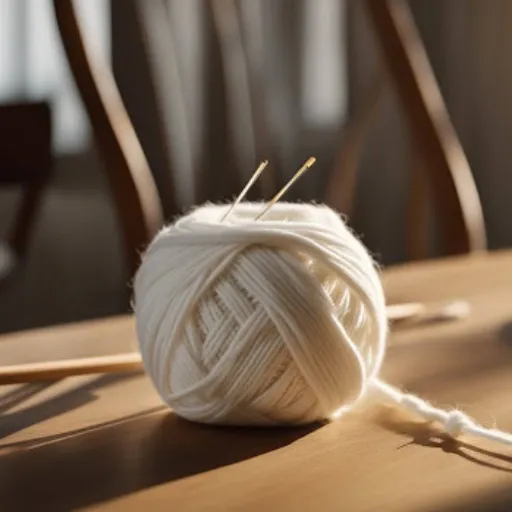
Comparative Overview of Synthetic and Natural Fibers
Synthetic fibers are durable and cost-effective, while natural fibers are eco-friendly and more breathable.
| Key Point | Synthetic Fibers | Natural Fibers |
|---|---|---|
| Durability | High | Moderate |
| Breathability | Low | High |
| Eco-Friendliness | Low | High |
| Cost | Low | High |
| Moisture Absorption | Low | High |
| Production Energy | High | Low |
| Biodegradability | No | Yes |
| Comfort | Moderate | High |
| Softness | Moderate | Very High |
| Resource Usage | Non-renewable | Renewable |
Benefits of Using Natural Fibers
Natural fibers, made from plants and animals whose resources come from nature, give us a variety of benefits that make them the best choice for people who want to buy environmentally friendly and sustainable products. These are the most important benefits of natural fibers, based on the latest information and numbers:
- Eco-Friendliness and Sustainability: Natural fibers, cotton, wool, silk, and hemp among others, are biodegradable and are still better to the environment than synthetics. The Textile Exchange study shows that the performance of natural fibers in terms of environmental impact is just a fraction of that of synthetics. To give an example, the production of 1 kg of wool results in emission of around 5 kg of CO2 equivalent while polyester production can emit more than 10 kg of CO2. Moreover, natural fibers are renewable while the synthetic ones are not, as they are made from fossil oil that is non-renewable.
- Breathability and Comfort: One of the key attributes of natural fibers is their high degree of breathability. Cotton is the most breathable of all fibers, allowing air to circulate and thus very suitable for summer. Wool is very highly regarded for its ability to insulate while also being breathable, hence the wearers can stay warm during winter and still be cool during summer. The natural fibers’ property of regulating body temperature provides comfort which can be discomfort otherwise. Surveys reveal that, over 65%, of shoppers prefer garments made of natural fibers due to their comfort and gentleness.
- Moisture Management: Natural fibers are far superior to synthetics in moisture absorption. Cotton has such an awesome quality that it can hold up to 27 times its weight in water, which is a reason why it is used in making towels and bedding besides other fabrics. Wool remarkably can take in moisture that amounts to 30% of its weight while at the same time removing it from the skin layer and thus preventing the occurrence of clamminess and discomfort.
- Health Benefits: Natural fibers are a great choice for people with allergies and those who have sensitive skin. Silk, for instance, is frequently advised for people with delicate skin because of its soft feel and natural anti-dust mite property. Likewise, organic cotton is considered to be less harmful as it is grown without the use of synthetic pesticides or fertilizers and thus the exposure to toxins is minimized.
- Support for Local Economies: The fiber industry is often a major income source for farmers from underdeveloped countries and cultivators around the world. The FAO (Food and Agriculture Organization) has stated that millions of farmers in developing countries, especially in India, China, and the USA, rely on growing cotton as one of their main income sources. Choosing natural fibers will enable you to help sustainable business practices that ensure income for small farmers and preservation of the old industries.
- Durability with Proper Care: When natural fibers such as wool and silk are maintained properly, they can remain in good condition for years without much degradation, hence decreasing the waste caused by fast-fashion. For instance, a woolen garment can go through a lot of wear and still retain its shape and strength.
The use of natural fibers in daily life will not only provide personal comfort but will also help in making a planet greener and more sustainable. The switch from synthetic to natural will let us cut down the resources used, encourage environmentally friendly behavior, and give a healthier environment to the next generations.
When to Choose Acrylic Yarn
Acrylic yarn is a superb option when you need a material that is inexpensive, versatile, and easy to maintain. Due to its synthetic nature, it is much cheaper than the natural fibers such as wool or cotton that are usually the source of yarns, hence, it is a go-to for a variety of projects. Besides, the spectrum of colors and the different textures of acrylic yarn are very wide, hence, there is a lot of scope in terms of the creativity when it comes to knitting or crocheting.
The main advantage that comes with acrylic yarn is its long-lastingness. Badly used, some of the natural fibers can break down, but not acrylic; it is off great quality and therefore pretty much the same over the years, even in daily usage or after laundry. For this very reason, blankets, scarves, and children’s clothing can be made from this yarn and will stand up to the rigors of constant washing and even normal wear. Moreover, it is also free from the attack of moth bugs, which consequently gives it a longer life.
Moreover, it is very much a fact that acrylic yarn is a very good choice for the people who are allergic to the natural fibers of wool. Usually, the softness and lightness of the yarn make it wearable for the people with allergies or skin sensitivities. Besides, the yarn has the advantage of being machine-washable and quick drying, which makes it an easy-going option for everyday use. Overall, acrylic yarn is a versatile and economical material that can meet the needs of various crafting projects.
Biodegradability of Acrylic Yarn
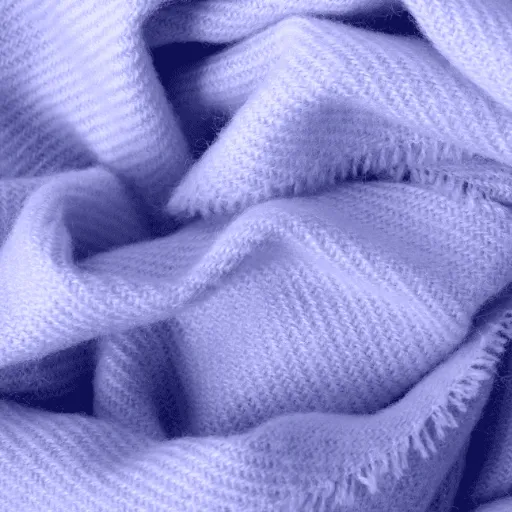
Is Acrylic Yarn Biodegradable?
Acrylic yarn is definite not to be biodegradable. This man-made fiber is made from a compound of fossil fuel, primarily acrylonitrile which is common plastic. Where natural fibers, for instance, wool or cotton, are quickly decomposed by nature, acrylic fiber, on the other hand, is very slow to be turned into soil. Therefore, once the acrylic yarn is thrown away, it can lay in a landfill for an extremely long time, that is, even up to centuries while contributing to the problem of chronic plastic pollution which is plastic waste in landfills that takes a lot of time to get rid of.
The reason why acrylic yarn is so resistant to any kind of decomposition is because of its makeup. To last long, synthetic fibers are made to be very strong and resistant to wear and tear. Unfortunately, the same environment resistant qualities also make it unapproachable by the microorganisms that ordinarily feed on organic matter and break it down. Thus, the property that is so good for handcrafters is creating a serious problem for the environment post-disposal of the yarn.
To lessen the impact of acrylic yarn on the environment, it is best to think of other fibers, save the remnants, and practice sustainable ways of crafting. The recycling programs for synthetic fibers are still very few, yet looking for green, no waste options and minimizing the use of non-biodegradable items like acrylic yarn are some of the efforts that can help in lessening the long-term impact of plastic materials on earth.
Common Misconceptions About Acrylic Yarn
One of the most widespread beliefs regarding acrylic yarn is that it is a total hazard and, therefore, should be completely disregarded. Nonetheless, it is still a fact that acrylic yarn is synthetic and non-biodegradable; however, the pros of it being a good choice for some projects do outweigh the cons. Its strong point is that it is a cheap and easy to get material, thus very available and handy for the creative as well as the beginner. But then again, the secret is to apply it wisely by mixing the technological convenience with sustainable practices.
The second fallacy is that acrylic yarn is unusable and unrecyclable. Even though the recycling of acrylic fibers like that of synthetic fibers is very limited, the life of the yarn can still be lengthened in other creative ways. Scrap materials left from the projects can be turned into smaller creative items, or unwanted yarn could be given to local crafting groups or organizations. All these practices can help cut down on waste and increase the use of acrylic yarn which is significant because of its environmental impact.
Finally, it is a widespread belief that using acrylic yarn for garments or knitting would be uncomfortable as it is a man-made fiber. Thanks to the modern production technologies, the texture and quality of acrylic yarn have been improved tremendously making it soft and multi-purpose for not only clothing and bedding but also for accessories. Although it might not be as breathable as natural fibers, it still comes with the benefits of being cheaper, easy to maintain, and long-lasting, hence making it a very practical option in many cases. By educating ourselves about both the positives and negatives of acrylic yarn, we can make greener and wiser choices.
Scientific Insights on Acrylic Yarn’s Environmental Footprint
The environmental footprint of acrylic yarn is predominantly the result of its synthetic composition and the manufacturing process. Acrylic, a plastic-type fiber formed from acrylonitrile, consumes fossil fuels for its production. This, in turn, leads to the release of greenhouse gases and the continuous depletion of non-renewable resources, making the plastic fiber less eco-friendly than natural fibers like cotton or wool.
Acrylic yarn’s non-biodegradable nature, on the other hand, is a major issue. Acrylic products have a lifespan of hundreds of years during which they are dumped in landfills and this leads to a long-term waste management problem. Microplastic particles are also released into the water system from acrylic fibers during use and washing, and thereby, they eventually reach oceans and harm marine life and ecosystems.
All these difficulties notwithstanding, there are a few measures in place to cut down the environmental impact of acrylic yarn. Recycling tactics together with renewable manufacturing practices are expected to greatly diminish emissions and waste. However, it is still very necessary for consumers to reflect on their choices if they were to consider factors such as cost and convenience along with the long-term ecological impacts of synthetic materials like acrylic yarn.
Sustainable Alternatives to Acrylic Yarn

Eco-Friendly Yarn Options
Natural fibers are the best alternative when it comes to sustainable options for acrylic yarn, for example, wool, which is minuscule, renewable, and strong, thus, the right choice for nature-loving crafters. Sheep’s wool is extremely hard to push, if not managed properly, to be sustainable and, at the same time, it gives the yarn warmth and elasticity thus giving the quality of knitting, crocheting, or weaving projects done with it.
Organic cotton yarn is another source of eco-friendliness, which is made from cotton plants that are kept free from all the pesticides and fertilizers. The technique used in producing organic cotton is that it preserves soil health, water and air quality, and lower carbon emissions. This yarn is very smooth and allows good air circulation, making it perfect for big projects like clothing and baby items that need to be lightweight.
Bamboo and hemp fibers are on the way to being most popular plant-based tradesman. Bamboo yarn is considered less resource demanding and fast-growing while hemp . Both have their individual characteristics of textures and are capable of being used in various crafting applications. So crafting becomes natural and sustainable when one chooses to replace acrylic yarn with any of these.
Crafting with Natural Fibers
Crafting with natural fibers brings along the pros of being environmentally friendly, functional, and aesthetically pleasing. The natural fibers that are available these days include cotton, wool, bamboo, and hemp, which are all biodegradable and hence, are not only a sustainable alternative to synthetic materials, like acrylic yarn, but also a better choice when it comes to the disposal of the material after use. Through the use of these fibers, the crafters can make a contribution in terms of waste reduction and lowering their ecological footprint. Furthermore, the resources consumed during natural fiber production are usually less, and the pollutants released during the same are also less, compared to the synthetic fibers.
Natural fibers also give the user the advantages of breathability, comfort, and durability. The natural fibers, like cotton and bamboo are very soft and light, hence making them perfect for the projects that demand skin-friendly textures, for instance, baby clothing or blankets. On the contrary, wool is quite good in terms of heat-retaining and stretchiness; thus, it is very good for making sweaters and scarves that need to be warm for the winter. Every type of fiber has its own distinct characteristics, thus allowing the crafters to pick up the materials that are best for their project needs.
Moreover, the natural fibers impart the crafted items an organic and timeless beauty. Their peculiar textures and vibrant, earthy colors not only attract the eye but also give the handmade articles a certain level of authenticity and charm. The use of natural fibers in creating crochet art, knitting garments, or weaving décor items can not only raise the quality of the final product but also support responsible crafting practices. The conscious choice of materials does not only enhance the creative aspect but also a cleaner and more sustainable future.
Practical Tips for Environmentally Conscious Crafters
- Choose Sustainable Materials: Eco-friendly and responsibly sourced materials are the ones to go for. These may be organic cotton, recycled yarns, bamboo fibers, and upcycled fabrics, among others. The use of these alternatives not only helps the crafters to lower the environmental impact of their projects but also plays a role to the more sustainable crafting industry.
- Minimize Waste: Make a precise and accurate plan for your projects to avoid buying more materials than you need. Get creative with scraps and leftovers instead of throwing them away. For example, fabric remnants can be made into smaller accessories, and extra yarn can be used for embellishments or small items like coasters.
- Repurpose and Upcycle: Why not breathe new life into worn-out items by turning them into trendy with repurposing? Buy new materials instead of making use of items that you don’t need anymore, like taking old clothes to patchwork or using jars and containers for DIY storage. This practice is not only a source of creativity but also decreases the amount of waste that goes to landfills.
Frequently Asked Questions (FAQ)
Q: Is acrylic yarn biodegradable?
A: Acrylic yarn is not biodegradable. It is a synthetic yarn that is made from petroleum-based products, mainly acrylonitrile, and, therefore, can take a really long time to decompose in the environment.
Q: How does acrylic yarn impact the environment?
A: The acrylic yarn’s lifecycle – production, use and disposal – poses a threat to the environment. It takes a very long time for the synthetic yarn to break down and its existence can therefore affect and pollute landfills. The manufacturing process can also create toxic/
Q: What are the alternatives to acrylic yarn?
A: There are various alternatives to acrylic yarn and they include natural yarns like wool and cotton. The yarns are biodegradable and normally exhibitions lower environmental impact over synthetic acrylic yarn.
Q: Can acrylic yarn be recycled?
A: Yes, there is recycled acrylic yarn available and it plays an important part in minimizing the environmental impact. But, not all acrylic yarn is recycled, so it is wise to inquire if the yarn you are getting is made from recycled materials.
Q: How long does it take for acrylic items to biodegrade?
A: It could be a very long process for acrylic items to biodegrade, and they sometimes linger in the environment for up to 20 years. This prolonged existence gives rise to issues concerning its environmental impact.
Q: Is acrylic yarn bad for the environment?
A: Acrylic yarn can be regarded as bad for the environment because of its synthetic character, which is, it is petroleum-based, and above all, it is non-biodegradable. Its formation itself can emit noxious gases.
Q: What are some yarn projects that can use alternative materials?
A: Besides acrylic, yarn projects could take advantage of organic cotton and wool. These fibers not only come from nature but also provide a biodegradable option along with a gentle touch and airiness.
Q: How does acrylic yarn compare to wool?
A: Acrylic yarn has been chosen widely for its low cost and multifunctionality, meanwhile when looking into the debate of acrylic vs. wool, wool is a fibrous natural material that decomposes and has better comfort with heat. Acrylic, however, is mostly more rugged and easier to maintain.
Q: What should I consider when buying yarn?
A: When it comes to buying yarn, you will have to think about the kind of yarn you will be working with. Do you prefer synthetic yarns like acrylic, or natural ones such as wool and cotton? Quite importantly, also consider the environmental effects of your decision and, if applicable, choose recycled acrylic yarn.
Q: Are there any health concerns with acrylic yarn?
A: Despite the fact that acrylic yarns are usually harmless for use, there are some people that may be allergic to synthetic fibers. Also, the washing of acrylic can cause microplastics to be released into the water, which adversely affects aquatic life.
References
-
The Needle Store – Does Acrylic Yarn Harm the Environment? – Discusses the environmental impact of acrylic yarn, emphasizing its non-biodegradable nature.
-
Weave and Wander Yarn – Acrylic Yarn and the Environment – Highlights the long decomposition time of acrylic yarn and its contribution to environmental issues.
-
Textile Yarn – Is Acrylic Yarn Biodegradable? – Explains the non-biodegradable nature of acrylic yarn and its role in microplastic pollution.
-
Thread Collective – Ethical Yarn Choices – Compares acrylic yarn to organic fibers, noting its persistence in the environment for hundreds of years.
-
Knitty Knightly – Acrylic Yarn Pros and Cons – Discusses the pros and cons of acrylic yarn, including its inability to biodegrade and its long decomposition time.








